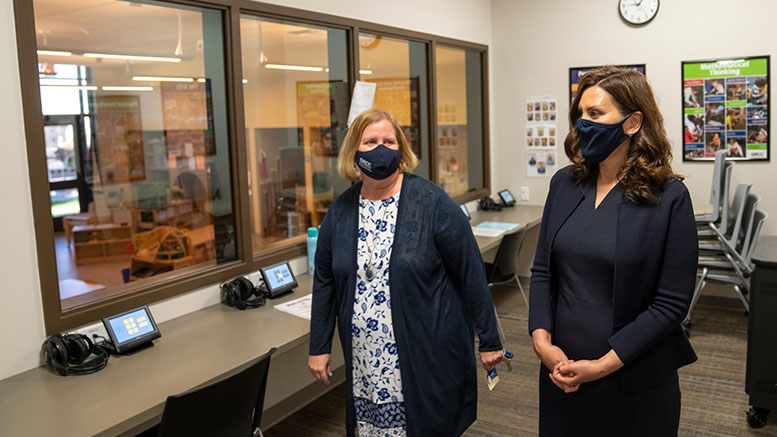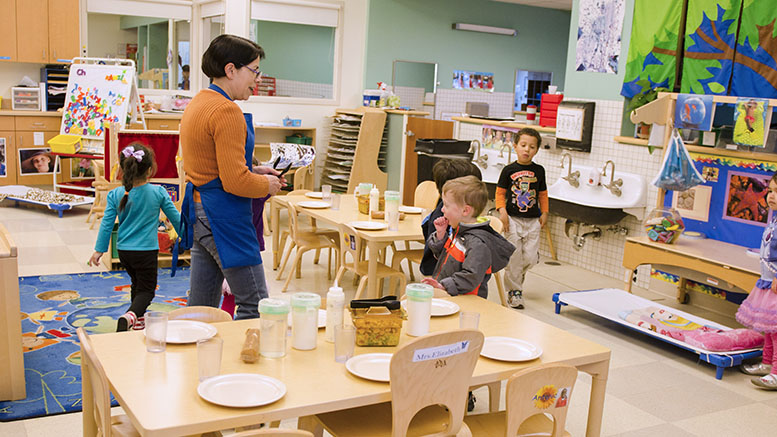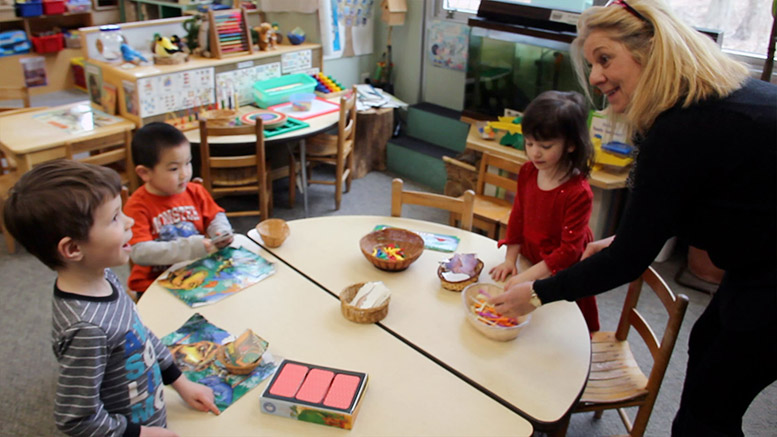A few years ago, some community colleges cut back on child-care services as demand fell. But since the pandemic began, need has grown as parents of young children found it hard to study at home with their children underfoot or they had to find affordable care while they worked.
Colleges have different approaches to child care. Some, like Clark College in Washington and Grand Rapids Community College (GRCC) in Michigan, have a child-care center right on campus. At those two colleges and some others, the child-care center is coordinated with students in the early childhood education program, who use the center as a learning lab. (See sidebar.)
Other community colleges, such as Indian River State College (Florida), use a U.S. Education Department program, CCAMPIS (Child Care Access Means Parents in School), to offer funds to students for child care. Some two-year institutions also use state programs to access funds. The colleges can help students use that money to place their kids in community child-care centers, to which college counselors help them find and apply.
Below is a sampling of child-care services at a few community colleges.
Kudos from the governor
The Fratzke Early Childhood Learning Laboratory at Grand Rapids Community College made the news recently when Michigan Gov. Gretchen Whitmer gave a speech there promoting access to child care for families throughout the state. In an event sponsored by the Early Neighborhood Learning Collaborative (ELNC) in Grand Rapids, Whitmer called the college’s Learning Lab “phenomenal.”
The child-care center has been part of the college for nearly 50 years. It rented space in a local church for several years until 2017, when the new building was completed on campus and the center moved there. The center is part of the college’s education department.
Parents with children in the center can be students (whose spaces are subsidized), college staff or members of the community, said Melissa Boman, director of the Fratzke center. The center has received some CCAMPIS funds to help student parents pay for child care.

The center also receives funding through ELNC, a local nonprofit that provides funding for early childhood education for at-risk families. It also works with the Great Start Readiness Program, a state program for 4-year-olds from families whose income is 250% below the poverty level.
The center closed for four months at the beginning of the pandemic. When it reopened, a lot of processes had to be changed, said Becky Brinks, head of the college’s education department.
The preschool classrooms housed half the number of children they had previously, 55 instead of the usual 105. More of the education majors were observing children from a booth instead of interacting with them directly. Strict cleaning protocols were put in place, and ventilation was increased.
Enrollment was limited during the pandemic to keep groups small, Brinks said. This fall, the center plans to be back to full capacity.
“There’s a huge need,” Brinks said. Twelve of the spots are reserved for student families. “There are very long waiting lists for private pay slots.”
Continued challenges
The child-care center on the main campus of Clark College also has a long history. It opened during World War II.
“It’s about student retention and motivation, and support for children,” said Michele Volk, director of child and family studies at the college. The center is also open to families in the community, and that enables student families to pay on a sliding scale, Volk said.
“We always maintain 65% or more spaces available to student parents because that’s part of our mission,” she added.
At its lowest point at the start of the pandemic in April 2020, the center had just 25 children enrolled in the center, a big drop from 131 in February. Today, 76 children are enrolled. There can be a waitlist for non-student families.
The center has dealt with plenty of challenges during the pandemic.
“The hardest part is tracking every week what changes we need to respond to,” Volk said. “We’ve put in place several procedures – screening tools, temperature checks, limiting the number of children in a classroom.
Related article: A long history in early childhood education
“We have maintained stable groups of cohort. The child is in one indoor space and one outdoor space so they’re not mixing with other children indoors,” Volk said. “That’s been helpful.”
The child-care center serves children aged 1 to 5 years old, with a summer camp for 5- to 10-year-olds. Last year, when elementary schools were teaching remotely, the center’s school-aged classroom stayed open for the full year.
“Families were going through so much uncertainty, they didn’t know what choices to make,” Volk said. “To have that sense of continuity for their children and families was very helpful.”
That program will not continue this year as elementary schools return to full-time, in-person learning. Volk anticipates enrollment of 75 to 80 children in the child care center, about half the usual level.
“So we’re looking at a significant challenge,” she said. “With change in the [delta] variant, some families or staff have communicated hesitation.”
Expanding awareness
At Dallas College in Texas, child care is part of the student care network wraparound services.
“Child care is one piece of it, making sure our students are cared for holistically,” said Cathy Edwards, associate dean of basic care and needs.
The services for students include intensive mental health, physical health, and food, shelter and child care – all necessary requirements to succeed in college.
“It’s really hard to study if you don’t know where your child is safely,” Edwards said.
Dallas College consolidated seven campuses last year and changed its name from Dallas County Community District, now with a single accreditation. Two of the campuses have child care, and the college is moving toward offering it on all seven, Edwards said.

Neither of the two programs is run by the college, but the college does refer students to them. One is a Head Start program, and both are based on sliding scale income eligibility. The child-care centers help find other locations for the students if the campus is not as convenient as one of the other locations.
About 10% of the children in the program belong to student parents.
“We are working on a stronger referral process to get more of our Dallas College students in the program at both locations,” Edwards said.
Her office also directs students to the state’s Working Wonders program, which offers a subsidy for child care to community college students pursuing a career (such as nursing) or technology degree. Students can use a program voucher to help pay for community child-care centers.
Eliminating a barrier to student success
Indian River State College (IRSC) is another community college where student parents are benefiting from a CCAMPIS grant.
“We did a student survey and found out that one of the biggest hindrances to student success was not having child care,” said Prashanth Pilly, who authored the grant and is dean of business technology. “Covid exaggerated it, when elementary school-age students were at home. [Student parents] were trying to take care of their kids, take care of their home, do their studies.”
The CCAMPIS grant enables students to get child care close to their home in four counties. In addition to the central campus in Fort Pierce, IRSC has four branch campuses in different counties.
Take our straw poll: Does your college provide some type of child care services for parent students?
Ashley Days is the IRSC CCAMPIS coordinator. Her office has partnerships with Early Learning Coalitions in the area to which she refers students. Twenty students qualified for the CCAMPIS grant in the spring semester and are receiving child care.
At least 20 more have applied for the fall, Days said. Some providers are full, and students go on a waitlist.
Days’ office provides parenting workshops and even helps student parents find the right academic advisor.
“Especially with some of the younger students, finding child care is overwhelming for them,” Days said. “They don’t know where to begin. I’ve been able to assist, even taking them to child-care centers on tours.
“One student had virtual classes,” Days added. “She had an infant. I said, ‘What are you going to do with your baby when you have to take an exam online?’ She hadn’t thought of that.”
Tapping various funding sources
In addition to CCAMPIS, New Jersey’s Bergen Community College is using a different federal program, the Higher Education Emergency Relief Fund (HEERF), created this year as part of the American Rescue Plan. HERFF funds are designed to support institutions of higher education to serve students during the pandemic.
“We wanted to make sure we could provide our students with help,” said Larry Hlavenka, Bergen’s executive director of public relations. “It’s incumbent upon us to try and remove financial barriers to their education.”
Bergen’s Child Development Center, which serves 2½- to 5-year-olds, has been operated by the college since 1982. It has spots for 45 children, and 25 of those will be fully funded by the HERFF and CCAMPIS grants.

Not all the spots are filled, and the college is contacting students who said in a survey they had trouble finding or paying for child care. The fall semester starts September 1.
The HERFF funds can be used through September 2022, Hlavenka said. He hopes the CCAMPIS money will last for a few years.
“There are multiple benefits to having that type of facility on your campus,” Hlavenka said. “It’s helpful to student parents and education majors. Plus, it’s an opportunity for the community to come on campus and see what we’re all about.”

